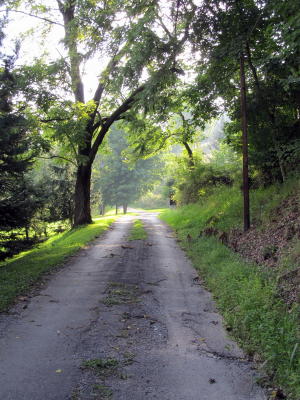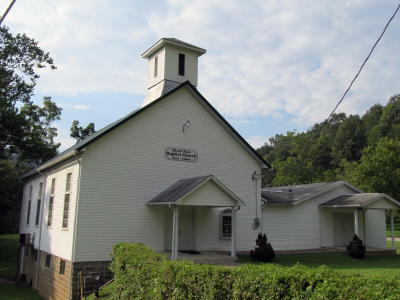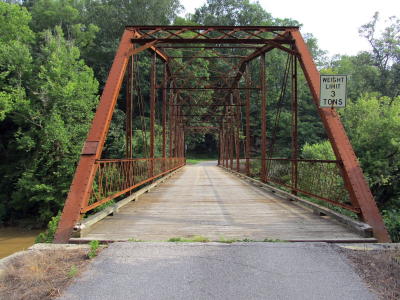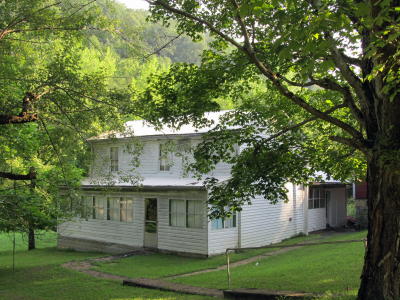
On this quiet and now near vacant road in 1911, was the bustling community of Apple Farm, up the holler toward Sand Ridge from main Steer Creek and the Doddrill Post Office, it had lodges, the Improved Order of Oddfellows, the Redmen, the Daughters of Pocahontas, a grist, a saw and shingle mill, stores, post office, school and "plenty of good honest citizens who are always glad to do good to any one who deserves help"
By Larry Stalnaker
glstalnaker@netscape.com
As I grow older, I find that my thoughts wander more and more to those yesterdays, when I was much younger, and life was much simpler.
I don't refer to my 20's or 30's, but rather to my childhood days, the formative years of my life when I started to be molded and shaped into the person I would become.
Through those memories, I find that I am able to take long, happy journey's to the places of my youth, and never leave the comfort of my recliner. I also find that while I might not remember what my wife asked me to do an hour ago, I have very vivid memories of people and places from that time, now nearly 70 years ago.
Last night I took such a trip to Apple Farm, WV the little rural community in Calhoun County where I was born and spent much of my early life.

The Apple Farm community joined the Steer Creekers
for worship service for well over a century
I started my journey from the parking lot of the Rush Run Baptist Church. Standing there, gazing down on Steer Creek, and looking around the Church property, I could see some of the people from long ago as they entered and left the Church.
Hughart Stump, and his wife, Bernice. Hughart was my cousin, and Bernice was one of my early school teachers. Keith Kendall, Rhymer Kendall, Frank Vannoy, Ms "Bug" Stump, members of the Shock family, the Gainers, Fowlers, Wilsons, and other members of the community who could be counted on to make an appearance each and every Sunday.
I leave the parking lot and walk those few yards up the road, and turn right to cross the bridge over Steer Creek and begin my journey up that dusty road that will lead to three of my early homes. Just after crossing the bridge, I stop to gaze at the huge Horse Chestnut tree, the scene of many a chestnut burr battle, then continue on, passing the entry to the one lane drive that led to the home of Aunt Mandy Bennett.
I don't tarry long there, as I am anxious to continue my journey and see the fantastic sights that I know awaits me. Yet, I can't help but pause a short distance down the road, and glance to the left, up the hollow leading to the ridge where I had many good mornings squirrel hunting.
Just beyond that, I pass the home of Mr. Minney, and the road that turns off to what I always referred to as Shock Hollow, where Mr. and Mrs. Holly Kendall, and Mr. & Mrs. Bob Shock lived and raised their families.
Perhaps 200 yards further up the road, I stop and set down on the road bank, and look at the home of my Maternal Grandparents, George and Bessie Wilson. If I concentrate hard enough, I can see the family as they all gather in for a Sunday visit. All of their children; Hugh, Henry, Luke, Johnny, Treacy, Bess, Osa, Donnie, Eda and Mary, with their families in tow, and enough good, home cooking to feed a small army.

The Steer Creek Bridge located at the former Village of Doddrill
is the gateway to the once bustling Apple Farm community,
although it has joined the worst bridges in West Virginia list
I smile as I recall how I and my cousins spent those Sunday afternoons, fishing with bent straight pins for hooks, running around like wild Indians, playing root the peg, catching lightning bugs, and other simple country pleasures that we enjoyed.
Teddy, the family collie is on the back porch, waiting only for someone to come out and say, "Teddy, go get the cows". With that command he would head up the hillside, and shortly return, driving the milk cows before him and take them to the barn for evening milking.
While I could stay and visit with these good folks for the rest of the day, I need to continue. The next home that I pass is that of Orval Smith, and another old friend of mine, his horse, "Chub".
I can remember many times helping Mr. Smith with various farm chores, and once hitched to the sled, Chub needed only to be told where to go. No touch of the reins, or any other guidance, he just went. Chub also was utilized to turn the mill when it was time to grind sugar cane and make molasses.
Now I come to one of the homes that I lived in as a child. It was always referred to as the Dobbins Place. I visualize the two story farm house with its upper and lower porches, and think of the time when we lived there.
The old house and barn are gone now.......burned some years ago, but they stand before me now in my mind, just as they were then. I go behind the house to our old cellar house. How I wish I could walk in there again, have a tin cup of milk out of the crock of milk with a head of cream formed on the top, perhaps an ear of pickled corn right out of the stone jar it was pickled in...or maybe go upstairs, where meat was being cured and with my trusty Barlow pocket knife, cut off a salty crust from a curing ham.
Food for the Gods!
I go up the hollow behind the house to the hanging rock. It was a huge overhang of rock, used for storing farm machinery from time to time, but now, I stand there and look at the people under it. Cowboys, Indians, cops, robbers, soldiers, mountain men, such an assortment.
All of them have the faces of my brother and me as we played our games and acted out the various roles. I remember the times we paused in our games to build a fire, get out the old faithful iron skillet, and cook over an open fire.
Or, perhaps just bake a couple of potatoes in the coals of the fire. This was also the scene where a horrid tragedy played out in later years, when Sheriff Park Richards was killed while making an arrest.
As I proceed with my journey, I pass the house where Trace Richards lived. Trace was a "farmhand" and my friend. He was an accomplished musician, and loved to play guitar and sing with his family. He taught me much about playing, and through him I learned some of the history and about the people who made up country music in those days.
I was with Trace, de-horning cattle for my Uncle Saul on that memorable New Year's day when we returned to his house, only to hear that Hank Williams had died. It was as though we had lost a personal friend. Every time I hear Tom T. Hall sing his song about "Clayton Delaney" I think of Trace. He was my Clayton Delaney.
Next up, the Charley Stump place, a second home that my parents acquired and I lived in for a period of time. It was there that I found (and lost) my first "fortune".
When my parents bought the place, there was a golden delicious apple tree that stood in the edge of the garden. I claimed it as mine, and they let me have it. Shortly after moving in, I found a swarm of bees, and my paternal grandfather (Rev. C. A. Stalnaker) caught them for me and helped me get them into a hive which we put under the apple tree.
About the same time Grandpa Wilson gave me two chickens and a rooster. I was a man of means. Fresh apples right off the tree, apple blossom honey, and eggs from my own beginner flock of chickens. Alas, in a period of one week, a storm blew down the tree, the tree fell on the bee hive, and on two consecutive nights an owl got in the chicken house, and I was wiped out.
I also remember that in the attic of that house Grandpa Stalnaker found some old church records and early writings that lead to him authoring a book "The History of The Mt. Pisgah Baptist Association".
I imagine that if I set here on the porch long enough, I will see an old Chevy sedan coming up the road, and that can only be Gib and Abner Wilson, two brothers who were rural mail Carriers.
They are heading for the Apple Farm Post Office, but I know that they always have a guitar and a mandolin in the back seat on top of the mail bags, and with just a little persuasion, they will get out, come and sit on the porch with me, I can get out the old Silvertone guitar, and perhaps we can scrub off a tune or two.
Mail service and entertainment, all in one vehicle.
Just a little further, the road takes a slight dip and passes through the stream bed, then as it starts to gain elevation again I come to the house where I was born in January of 1943.
While it may have been my birthplace, it will forever, in my mind, be the home of Hughart and Bernice Stump. I remember stopping there on my walk home from school and helping take care of their sheep.
This is another of the houses that burned in later years, fire protection in rural areas being virtually unheard of. Hughart and Bernice played a big part in my "social" life, as they had the only television in the area, and being family, I could go there sometimes of an evening and watch TV with them. They also provided many trips to Grantsville for football or basketball games.

The S. L. and Treacy Stump homestead was once the
site of the Apple Farm post office and a nearby store
Separated only by a huge field, the next home is that of my Aunt and Uncle (Hughart's parents). S.L. and Treacy Stump. It was also the location of the Apple Farm Post Office.
My Mother, Eda Stalnaker, was postmaster there for a period of time, then Aunt Treacy served as Postmaster until the closing of the Post Office.
A lady named Lulu Robinson carried mail on horseback through the countryside, and I well remember waiting there for her to come and in drop off mail for posting as well as picking up the mail to be delivered. While she was busy in the Post Office, I could always manage to "borrow" her horse for a ride.
Thank God they had stopped hanging horse thieves by then!
Another great time at the Post Office was in the spring when shipments of baby chicks would come in, shipped in cardboard boxes from Rhodes Hatchery in Spencer, WV. If I close my eyes and listen, I can hear them now, cheeping and anxious to be on their way.
Well, just another half mile, and I am at the end of today's walk at the Upper Rush Run School. It was an old, one room country school, where each row of seats was a separate grade, 1st row, 1st grade, 2nd row, 2nd Grade, etc.
In the middle of the room stands an old, cast iron, pot-belly stove, the one source of heat for the school. Right now, if I listen closely, I can hear the sizzle created by a certain young lady who was a snuff user spitting on the side of the stove, nameless of course.
Recess and lunch time was filled with softball, sometimes football, tag, base, dodge ball, and just about every form of fun that we could think of.
We sometimes got to travel to some of the other small schools in the area for a softball game, or sometimes for what was referred to as a field day. We were probably the only rural school in the county at the time that had a hot lunch program. We would have box socials, with all proceeds going to the program.
An electric hot plate was purchased, as well as paper bowls and plastic spoons. Soup was bought by the case, and during the winter months, when many of the students walked as much as three miles to school, a hot bowl of soup was a godsend as compared to a cold sandwich.
I never knew for sure, but I always suspected that when the money from the box socials was depleted (and it couldn't have taken long) Hughart and Bernice kept the program going with their own money.
Good people from a bygone era.
Since my apple tree/honey bee/chicken enterprise had been wiped out, I worked as janitor at the school, coming in early, getting the fire going, cleaning up, and during the summer months mopping the floor with oil, to hold down the dust.
For this I was paid the magnificent sum of $14.00 per month. While that may sound small, it was a veritable fortune at that time. It went a long way toward the purchase of school supplies, and sometimes clothes.
Of course, I did manage to hold out a portion for the necessities of life, candy, a soda pop, a movie, and such. I think I will walk over there to the outdoor pump, and get a drink of good, cold water from the communal dipper, and let my journey for today be over. But I can assure you, as I get up from the recliner to go about the rest of my day in real life, I am much refreshed and relaxed, with my mind wiped clear of the burdens of everyday living.
And I know that when things get rough, or I start to let a little pity party get started, all I have to do is close my eyes, and take another wonderful vacation in time.
See RUBE STUMP REMEMBERS APPLE FARM
Community Hard Hit by Korean War in 1950
Apple Farm Remembered (Part I) in 1968
Apple Farm Remembered (Part II) in 1968
| 


